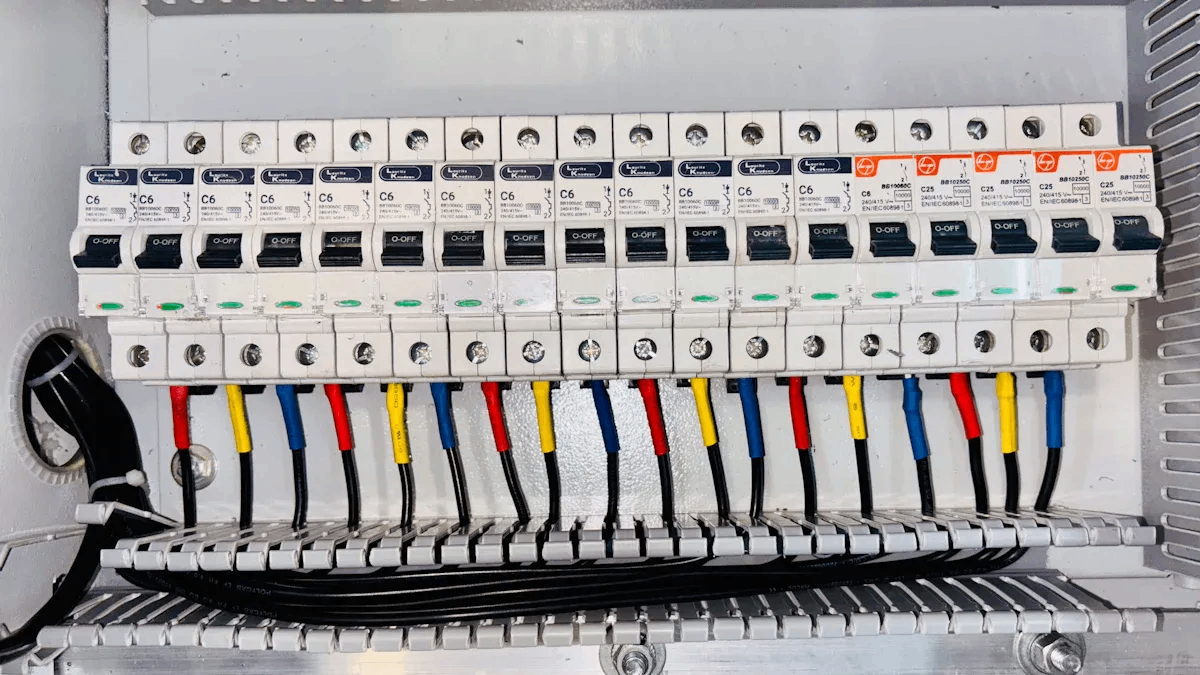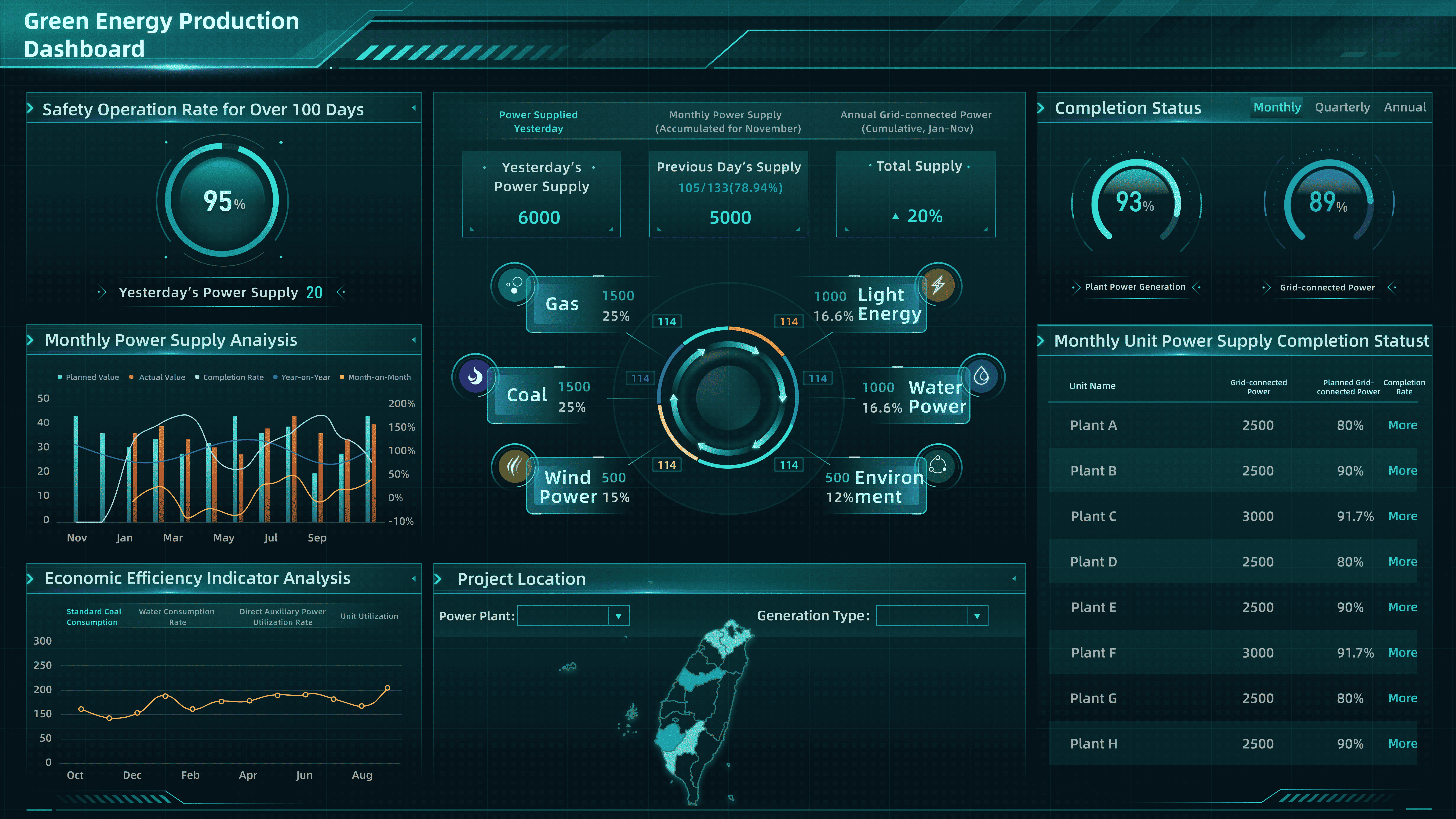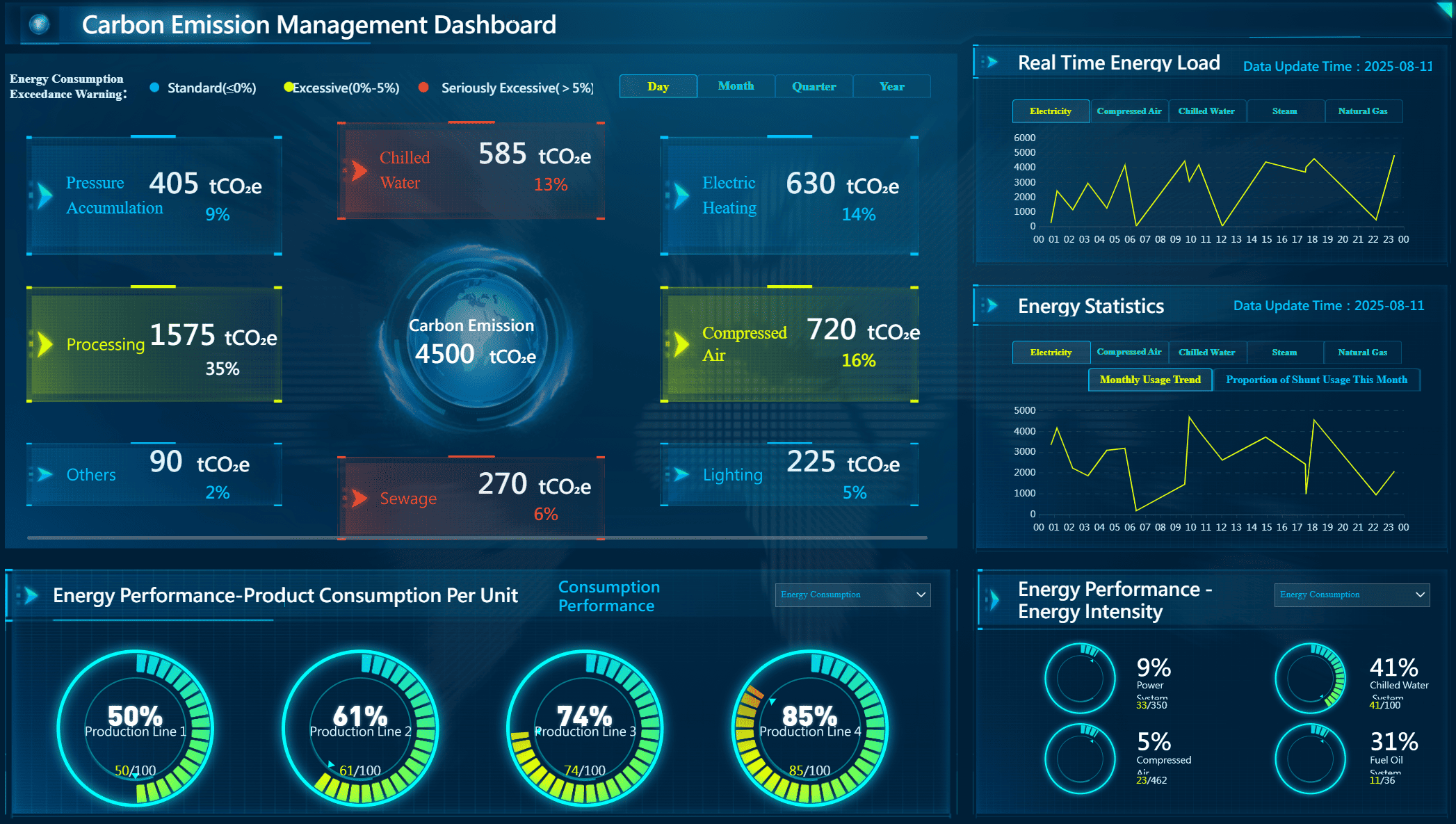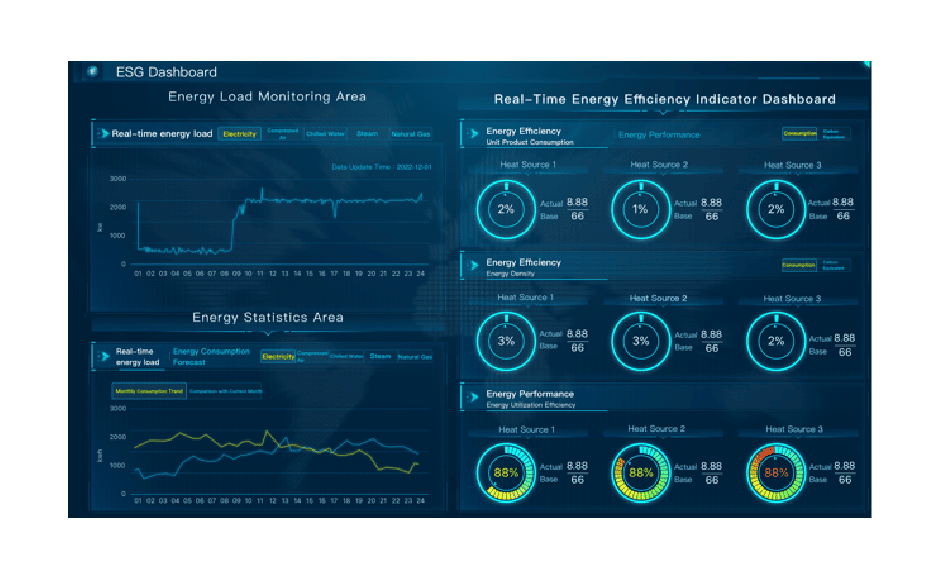Energy management solutions help organizations monitor, control, and optimize energy use across facilities. An energy management system collects real-time data from various sources, enabling businesses to improve efficiency and reduce costs. The global market for energy management solutions reached nearly USD 53 billion in 2023, reflecting strong demand for advanced energy management. Recent studies show that these systems use smart sensors and analytics to detect inefficiencies, providing actionable insights for better energy efficiency. Brands like FanRuan and products such as FineReport deliver energy solutions with reliable monitoring and reporting, supporting smarter energy management decisions.
Key Takeaways
- Energy management solutions use hardware, software, and data analytics to monitor and control energy use in real time.
- These systems help organizations spot energy waste quickly, make smart adjustments, and improve efficiency continuously.
- Implementing energy management solutions can reduce energy costs by around 15% or more and support sustainability goals.
- Applications range from homes to industrial facilities, offering tailored tools to optimize energy use and lower emissions.
- Platforms like FanRuan and FineReport provide clear reports and dashboards that empower better energy decisions.
Energy Management Solutions: Components

Hardware
Energy management solutions rely on a range of hardware components that collect and transmit data. Sensors measure temperature, humidity, and power consumption in real time. Meters track energy usage across different systems. Control units manage devices such as solar panels, heat pumps, and battery storage, allowing for immediate adjustments to optimize energy consumption. Gateways act as bridges, gathering data from various sources and sending it to the energy management system for analysis. Blade servers provide compact computing power, hosting energy management software and supporting visualization and control. Actuators enable physical changes in equipment, helping avoid overproduction and waste. User interfaces display energy flows and allow users to set preferences for transparent management.
Tip: Modern hardware, like smart meters and sensors, improves accuracy and enables real-time monitoring, which boosts efficiency.
| Hardware Component | Function |
|---|---|
| Control Units | Manage and adjust energy producers for optimal consumption. |
| Sensors | Collect data for forecasts and real-time adjustments. |
| Actuators | Enable system changes to optimize energy use. |
| User Interfaces | Visualize energy flows and allow user control. |
Software
Software forms the backbone of any energy management system. Platforms such as FineReport and FanRuan integrate data from multiple sources, providing dashboards and reports for easy analysis. Energy management software includes auditing tools, modeling programs, and benchmarking applications. These solutions help organizations track energy consumption, simulate scenarios, and compare performance. Real-time operation and control software, like SCADA and EMS, monitor and adjust system parameters, supporting demand response and load balancing. Dashboards display interactive energy information, engaging stakeholders and promoting efficiency initiatives.
| Software Category | Example Platforms | Key Features and Functions |
|---|---|---|
| Energy Auditing Software | EnergyCAP, FineReport | Collect/process data, generate reports, recommend improvements. |
| Energy Management System Software | FanRuan-en, SCADA, EMS | Real-time monitoring, control, demand response, load balancing. |
| Energy Dashboard Software | FineReport, Eniscope | Interactive display, stakeholder engagement, efficiency tracking. |
Below is a Power Management Dashboard.
Data Analytics
Data analytics drives the effectiveness of energy management solutions. Analytics tools process large volumes of energy data, uncovering patterns and identifying inefficiencies. Organizations use analytics to optimize operations, detect faults early, and integrate renewable energy sources. In manufacturing, analytics track machine performance, preventing downtime and improving productivity. In buildings, analytics optimize HVAC and lighting systems, enhancing energy efficiency and comfort. Advanced AI and machine learning support predictive maintenance and automated decision-making, leading to continuous energy savings. Energy management software like FineReport enables real-time data collection and analysis, helping organizations make informed decisions and meet regulatory requirements.
Note: Data analytics not only improves efficiency but also supports sustainability by identifying energy-saving opportunities and reducing waste.
Energy Management Solutions: Operation
Monitoring
Monitoring forms the foundation of every energy management system. These systems collect energy consumption data from electricity, heat, water, and gas using advanced meters and submeters. Sensors and counters gather real-time data about energy use across buildings, equipment, and processes. The energy management system visualizes this data, allowing users to track minute-by-minute changes and spot trends.
Energy monitoring enables organizations to identify energy waste quickly. Intelligent analysis tools flag faults and inefficiencies as they happen, prompting immediate corrective actions. Real-time alerts notify users when unnecessary energy use occurs, supporting fast responses. The system generates Key Performance Indicators (KPIs) to help set and track energy targets. Monitoring also supports sustainability goals by providing data-driven tracking and baseline setting.
A typical energy management system follows these steps for effective monitoring:
- Conduct an initial energy audit to understand current energy consumption patterns.
- Set specific efficiency goals based on organizational priorities.
- Deploy advanced meters and submeters for continuous data collection.
- Use data collection software and analysis tools to process information and identify risks.
- Train personnel and establish communication plans for smooth operation.
- Regularly monitor and fine-tune the system to maintain and improve performance.
- Review and update energy conservation measures based on insights from ongoing monitoring.
FineReport plays a key role in monitoring by supporting real-time tracking and visualization of large-scale terminal data. Its Trajectory Map plugin animates location data, making it possible to track millions of devices. The Sankey diagram feature visualizes energy flows, helping organizations identify energy waste and optimize consumption.

Monitoring with an energy management system provides the visibility needed to make informed decisions and achieve efficiency goals.
Control
Control is the next critical process in an energy management system. Real-time monitoring and dynamic load orchestration allow users to manage large energy loads instantly. Cloud-enabled platforms provide access to actionable data anytime and anywhere. Integration with renewable energy sources, such as solar panels and battery storage, supports optimized energy use.
Smart building automation centralizes control of lighting and HVAC systems. AI-driven HVAC management proactively adjusts units to prevent demand spikes and reduce costs. Indoor Air Quality systems monitor and adjust ventilation and temperature using sensor data. Autonomous load management protects critical infrastructure during grid disturbances.
Energy management systems use advanced load control to optimize device operation timing, reducing demand charges and improving efficiency. Flexible API integration enhances load management and device control. Scalable solutions meet the needs of single homes and large industrial facilities.
FineReport enables ongoing control and optimization by offering flexible report design and real-time data access. Its server-side features, such as caching and connection pooling, ensure high performance for large-scale, real-time data processing. Multi-dimensional analysis and mobile access support timely and interactive reporting, making control more effective.
| Control Feature | Description |
|---|---|
| Real-time load orchestration | Instantly manage large energy loads |
| Cloud-enabled access | View and act on data from anywhere |
| Smart automation | Centralize control of lighting and HVAC |
| API integration | Enhance device control and load management |
| Scalable solutions | Adapt to homes, buildings, and industrial facilities |
Optimization
Optimization ensures that an energy management system delivers continuous improvement. The system uses advanced algorithms to identify energy waste and maximize efficiency. Model Predictive Control (MPC) predicts system behavior and adjusts control actions in real time. Demand-side management guides users to change electricity usage habits, reducing peak demand.
Genetic Algorithms and Particle Swarm Optimization find optimal energy consumption patterns while maintaining comfort. Reinforcement Learning dynamically adjusts control strategies based on environmental conditions, achieving significant energy savings. Hybrid algorithms combine predictive and heuristic methods for storage energy management optimization.
AI and machine learning techniques support real-time monitoring, fault detection, predictive maintenance, and energy demand forecasting. These methods help organizations identify energy waste and improve system efficiency. Energy optimization relies on continuous data analysis and adaptive control.
Optimization in energy management systems leads to lower costs, reduced waste, and improved sustainability.
Below is a carbon emission management dashboard.

Benefits of Energy Management Solutions
Energy Efficiency
Energy management solutions help organizations achieve higher energy efficiency by monitoring and controlling energy consumption in real time. These systems use advanced sensors and analytics to identify energy waste and recommend improvements. Businesses often see a reduction in energy use of around 15% after implementing energy management strategies. Some companies have reported savings of 30% or more. For example, one customer saved €28,000 within four months by installing sensors and following expert advice. Most organizations recover their investment within a year, showing the effectiveness of these solutions.
Energy management programs provide tools to measure, track, and benchmark energy use. This approach helps organizations set clear goals and monitor progress. By identifying energy waste, companies can make targeted changes that enhance efficiency and support sustainable operations. FanRuan’s business intelligence platforms, such as FineReport, deliver data-driven insights that empower decision-makers to optimize energy management strategies and achieve continuous improvement.
Tip: Real-time monitoring and analytics allow organizations to spot inefficiencies quickly and take immediate action.
Cost Savings
Cost savings represent a major benefit of energy management solutions. By treating energy as a controllable cost, organizations can focus on continuous improvement and reduce energy expenses. For instance, The Summit saved over $29,000 each month, while Google achieved $1 billion in energy cost reductions after adopting energy management methodologies. On average, businesses save about 15% on their energy bills, with some reaching even higher savings.
Industrial facilities benefit from comprehensive energy audits and optimization strategies. These efforts can yield energy savings of over 40% in some cases. For example, a medical device manufacturing facility saved nearly $500,000 and reduced carbon emissions by 11% in one year. Energy management programs help facilities align energy use with real-time electricity prices, maximize self-generated energy from renewable energy sources, and reduce maintenance costs. The following table highlights key ways energy management solutions reduce costs:
| Cost Reduction Method | Description |
|---|---|
| Real-time monitoring | Enables data-driven decision making |
| Load shifting | Moves energy use to off-peak times for lower rates |
| Maximizing self-generated energy | Uses renewable energy sources to cut grid expenses |
| Dynamic load management | Minimizes peak demand charges and grid fees |
| Asset optimization | Reduces maintenance and operational costs |
Sustainability
Sustainability stands as a core advantage of energy management solutions. These systems help organizations reduce their environmental footprint by lowering energy consumption and integrating renewable energy sources. For example, McLaren Construction Group achieved a 44% reduction in energy use and a 41% decrease in CO2 emissions at a London site by using AI-powered smart socket technology. Other organizations have seen energy savings between 20% and 47%, with significant reductions in carbon emissions.
Strategic energy management programs deliver measurable sustainability outcomes. In the first year, organizations often achieve an average energy savings of 5%. Programs have resulted in over 1.7 billion kWh in electricity savings and more than 1.7 million tons of greenhouse gas reductions. These results come from combining energy assessments, operational improvements, and behavioral changes.
- AI-powered smart sockets reduce waste from devices like computers and heaters.
- Energy savings in commercial settings range from 20% to 47%.
- Payback periods for these technologies often fall between 3 to 18 months.
- Environmental benefits include significant reductions in carbon footprints.
FanRuan’s business intelligence solutions enable organizations to track sustainability metrics, report progress, and support long-term environmental goals. By leveraging real-time data and advanced analytics, companies can build more sustainable operations and demonstrate their commitment to responsible energy management.
Below is an ESG dashboard.

Examples of Energy Management Solutions
Energy Monitoring System
An energy monitoring system helps organizations track and manage energy use across different facilities. These systems provide several key features that support efficient energy management:
- Real-time monitoring allows users to observe energy usage instantly. This helps identify unusual patterns and respond quickly.
- Detailed data analytics convert raw energy data into useful insights. Users can spot trends and predict future needs.
- Comprehensive reporting tools create customizable dashboards and reports for different stakeholders.
- Customizable alerts notify users when energy use exceeds set limits.
- Scalability lets organizations expand the system as their needs grow.
- A user-friendly interface makes it easy for anyone to access and understand energy data.
- Integration capabilities connect the system with existing hardware and software.
- Security features protect sensitive energy information.
- Remote access enables users to manage the system from anywhere.
- Energy budgeting and forecasting tools help plan for future costs.
- Environmental impact metrics track progress toward sustainability goals.
Organizations use these systems to improve energy efficiency, reliability, and sustainability. Common metrics include energy intensity, total energy consumption, and the energy efficiency ratio. These metrics help track performance, identify waste, and compare results with industry standards.
Tip: Using an energy monitoring system helps companies reduce unnecessary energy waste and improve overall performance.
FanRuan Solutions
FanRuan offers practical solutions for energy management in real-world scenarios. For example, manufacturing plants use FineReport to monitor equipment and optimize energy use. The system collects real-time data from sensors and meters, then analyzes it to find inefficiencies. Managers receive clear reports and dashboards that highlight areas for improvement.
FanRuan solutions address common challenges such as inefficient data collection and equipment reliability issues. Automated data gathering reduces manual errors and centralizes energy information. Real-time monitoring detects faults early, helping prevent breakdowns and energy loss. The system supports structured upgrade planning, making it easier to improve energy systems over time.
Organizations benefit from improved energy efficiency, lower costs, and better sustainability outcomes. FanRuan solutions help track key metrics like energy consumption and carbon footprint, supporting compliance and reporting needs. These tools empower decision-makers to set energy targets, monitor progress, and achieve long-term goals.
| Challenge | Solution |
|---|---|
| Inefficient Data Collection | Automated data gathering and centralized energy information |
| Unnecessary Energy Wastage | Real-time monitoring and early fault detection |
| Lack of Upgrade Planning | Structured upgrade projects supported by smart technologies |
Note: FanRuan solutions make energy management easier and more effective for organizations in various industries.
Energy management solutions deliver lasting benefits for homes, businesses, and industries. Facility managers gain centralized data, real-time dashboards, and automation that help them identify inefficiencies, benchmark performance, and create targeted action plans. Advanced systems use AI to optimize energy use, reduce costs, and improve comfort. Research shows that organizations with structured energy management achieve consistent savings, better productivity, and greater resilience. Unlike traditional methods, modern solutions provide real-time monitoring, predictive maintenance, and seamless integration, leading to up to 30% energy cost reductions. FineReport empowers users with actionable insights, supporting smarter energy decisions and long-term sustainability. Exploring the right energy management system can help any organization reach its efficiency and environmental goals.
Continue Reading about Energy Management Solutions
How Data Management Consultants Boost Operational Efficiency
What is Product Data Management Software and How it Works
What Does a Data Management Specialist Do?
What is ESG data management and why does it matter
Why Carbon Management Is Becoming a Strategic Business Advantage
FAQ

The Author
Lewis
Senior Data Analyst at FanRuan
Related Articles

Top 10 Supply Chain Visibility Tools for 2025
Compare the top 10 supply chain visibility tools for 2025 to enhance real-time tracking, integration, and predictive analytics for efficient operations.
Lewis
Oct 29, 2025

Carbon Emission Management Explained and Why It Matters
Carbon emission management involves tracking and reducing greenhouse gases to meet regulations, cut costs, and protect the environment.
Lewis
Oct 12, 2025

What is Green Manufacturing and Its Key Principles
Green manufacturing uses eco-friendly processes to boost energy efficiency, reduce waste, and promote sustainable materials in production.
Lewis
Oct 10, 2025




